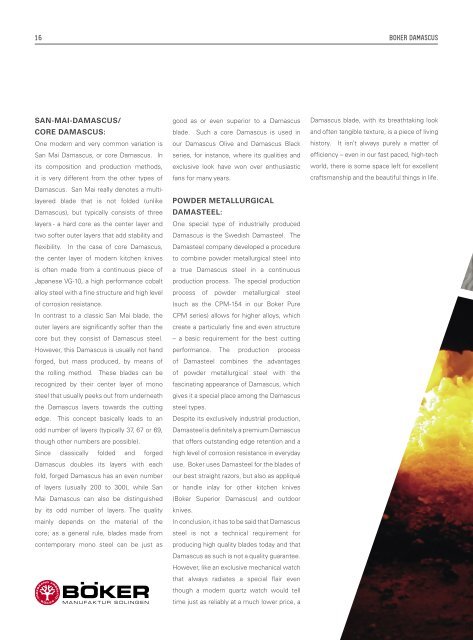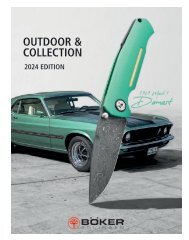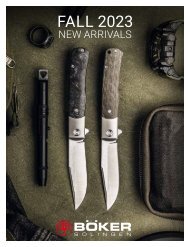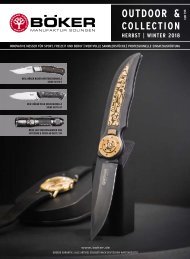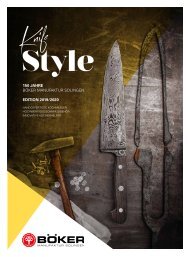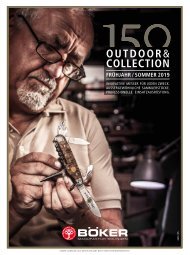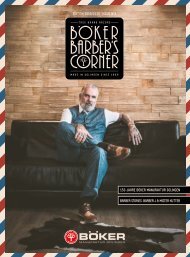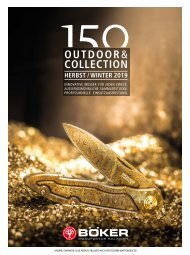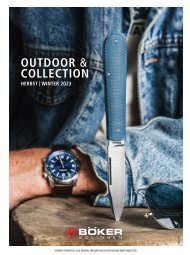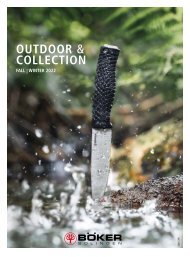Boker Knifestyle | EN Edition 2018 / 2019
Create successful ePaper yourself
Turn your PDF publications into a flip-book with our unique Google optimized e-Paper software.
16 BOKER DAMASCUS<br />
SAN-MAI-DAMASCUS/<br />
CORE DAMASCUS:<br />
One modern and very common variation is<br />
San Mai Damascus, or core Damascus. In<br />
its composition and production methods,<br />
it is very different from the other types of<br />
Damascus. San Mai really denotes a multilayered<br />
blade that is not folded (unlike<br />
Damascus), but typically consists of three<br />
layers - a hard core as the center layer and<br />
two softer outer layers that add stability and<br />
flexibility. In the case of core Damascus,<br />
the center layer of modern kitchen knives<br />
is often made from a continuous piece of<br />
Japanese VG-10, a high performance cobalt<br />
alloy steel with a fine structure and high level<br />
of corrosion resistance.<br />
In contrast to a classic San Mai blade, the<br />
outer layers are significantly softer than the<br />
core but they consist of Damascus steel.<br />
However, this Damascus is usually not hand<br />
forged, but mass produced, by means of<br />
the rolling method. These blades can be<br />
recognized by their center layer of mono<br />
steel that usually peeks out from underneath<br />
the Damascus layers towards the cutting<br />
edge. This concept basically leads to an<br />
odd number of layers (typically 37, 67 or 69,<br />
though other numbers are possible).<br />
Since classically folded and forged<br />
Damascus doubles its layers with each<br />
fold, forged Damascus has an even number<br />
of layers (usually 200 to 300), while San<br />
Mai Damascus can also be distinguished<br />
by its odd number of layers. The quality<br />
mainly depends on the material of the<br />
core; as a general rule, blades made from<br />
contemporary mono steel can be just as<br />
good as or even superior to a Damascus<br />
blade. Such a core Damascus is used in<br />
our Damascus Olive and Damascus Black<br />
series, for instance, where its qualities and<br />
exclusive look have won over enthusiastic<br />
fans for many years.<br />
POWDER METALLURGICAL<br />
DAMASTEEL:<br />
One special type of industrially produced<br />
Damascus is the Swedish Damasteel. The<br />
Damasteel company developed a procedure<br />
to combine powder metallurgical steel into<br />
a true Damascus steel in a continuous<br />
production process. The special production<br />
process of powder metallurgical steel<br />
(such as the CPM-154 in our <strong>Boker</strong> Pure<br />
CPM series) allows for higher alloys, which<br />
create a particularly fine and even structure<br />
– a basic requirement for the best cutting<br />
performance. The production process<br />
of Damasteel combines the advantages<br />
of powder metallurgical steel with the<br />
fascinating appearance of Damascus, which<br />
gives it a special place among the Damascus<br />
steel types.<br />
Despite its exclusively industrial production,<br />
Damasteel is definitely a premium Damascus<br />
that offers outstanding edge retention and a<br />
high level of corrosion resistance in everyday<br />
use. <strong>Boker</strong> uses Damasteel for the blades of<br />
our best straight razors, but also as appliqué<br />
or handle inlay for other kitchen knives<br />
(<strong>Boker</strong> Superior Damascus) and outdoor<br />
knives.<br />
In conclusion, it has to be said that Damascus<br />
steel is not a technical requirement for<br />
producing high quality blades today and that<br />
Damascus as such is not a quality guarantee.<br />
However, like an exclusive mechanical watch<br />
that always radiates a special flair even<br />
though a modern quartz watch would tell<br />
time just as reliably at a much lower price, a<br />
Damascus blade, with its breathtaking look<br />
and often tangible texture, is a piece of living<br />
history. It isn’t always purely a matter of<br />
efficiency – even in our fast paced, high-tech<br />
world, there is some space left for excellent<br />
craftsmanship and the beautiful things in life.


